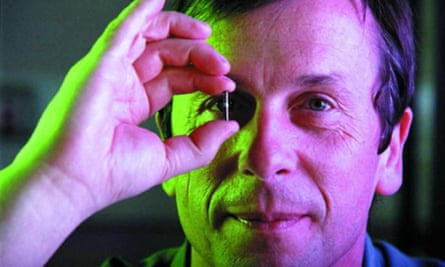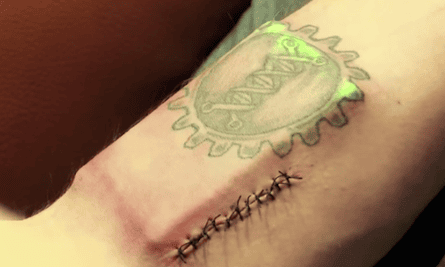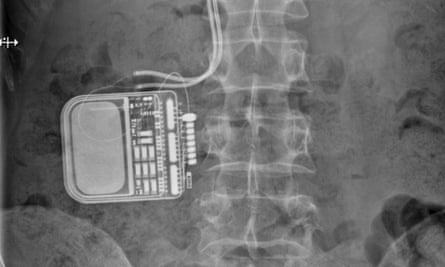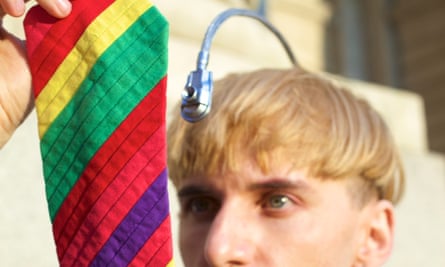When the director of a research institute called the Alternate Anatomies laboratory says he’s got something up his sleeve, you can safely assume it’s not just a figure of speech.
For Professor Stelarc, an Australian performance artist whose previous party tricks have included using a robotic third arm and letting his muscles be remotely controlled by a computer, growing a human ear on his arm was the obvious next step. Now, he wants to connect it to the internet.
Nine years in the making, Stelarc’s third ear is part surgically modelled, part grown from his own flesh – the result of an artificial implant that’s been left to fuse with his body. It began as an ear-shaped bio-polymer scaffold, inserted beneath his skin, which was then suctioned over the scaffold. Within six months, cell tissue and blood vessels had grown around the armature and now, the next step is to give it a more three-dimensional form, lifting the ear proud of the arm and adding an earlobe grown from his own stem cells. Not to mention making it Wi-Fi enabled.
“This ear is not for me,” Stelarc, whose experimental lab is based at Curtin University in Perth, told ABC News. “I’ve got two good ears to hear with. This ear is a remote listening device for other people. They’ll be able to follow a conversation or hear the sounds of a concert, wherever I am, wherever you are.” He plans to add a GPS tracker, so people will be able to follow his movements remotely, 24/7.
“There won’t be an on-off switch,” he added. “If I’m not in a Wi-Fi hotspot or I switch off my home modem, then perhaps I’ll be offline. But the idea is to try and keep the ear online all the time.”
He had the idea in 1996, but it took a decade before he found a team of surgeons willing to make it a reality. The project began as a quarter-scaled ear, grown outside his body, to be grafted on to his head, but the ambition grew into a full-size organ, complete with communicative capabilities. He has already tried to implant a microphone into the ear once. It functioned successfully at first, but had to be removed because of an infection. He hopes this won’t be a problem second time around.
Stelarc is by no means alone in attempting to augment his own body with electronic implants. As Bluetooth and Wi-Fi enabled devices become ever smaller, and access to the technical know-how ever more open, a whole community of budding DIY cyborgs has emerged. Known as grinders, these body-hackers have stuck everything from tracking devices and magnets to battery supplies and LED lights under their skin. Their gruesome kitchen-sink procedures are often uploaded to YouTube, with tips and tricks enthusiastically discussed on online forums, and wetware (the biological equivalent of hardware) implants offered at weekend meet-ups. Here are some of the experiments they’ve conducted on themselves.
Project Cyborg

Declared “the world’s first cyborg”, Kevin Warwick is the academic face of biohacking, less bio-punk than bio-prof, as professor of cybernetics at the University of Reading. In 1998 he was one of the first people to have an RFID tag implanted in his arm, which tracked him around the campus, letting him open doors without touching them and making lights switch on when he walked into his lab. Christened Project Cyborg, his experiments later extended to more sophisticated implants, including a 100-electrode chip implanted into the nerve fibres of his arm in 2002 that transmitted signals from his wrist to a computer.
DIY health tracker

Bio-hacker Tim Cannon took a more DIY approach when he inserted a chunky device the size of a pack of cards beneath his skin to monitor his temperature and blood pressure – two biometrics that can be read from outside the body just as accurately. The Circadia was designed to communicate with a thermostat, controlling the climate of a room based on a person’s body temperature, as well as send the person text messages when it thinks they might be getting a fever. After the battery played up and he started suffering from panic attacks, Cannon had the device removed after three months. But his company, Grindhouse Wetware, is now developing Circadia 2.0, which will apparently be able to detect blood glucose and oxygenation levels, as well as blood pressure and heart rate data. They are also planning a gesture-sensitive silicon implant for the back of the hand called North Star; tap it and it will glow red, during which time you will be able to use it to send Bluetooth commands to your phone.
Headphone implants
Fed up of losing your headphones? You could get them grafted into your head. That’s what amateur grinder Rich Lee did, by implanting tiny magnets in his ears that pick up signals from a wire coil around his neck, connected to a music player, to generate sound. This means he can listen to music without anyone knowing – though stealthy listening wasn’t his main motivation. He had the magnets installed when he discovered he was going blind. He decided that he could compensate for his loss of vision by learning to echolocate, just like a bat, interpreting the shape and dimensions of his surroundings based on how they react to emitted sound waves. And his ambitions don’t end there. “If I can have x-ray vision through some cybernetic technology I will have it,” he told the Guardian, “even if it requires an ocular prosthetic that leaves me looking like a monster.”
Night vision eyedrops

For California biohacking group Science for the Masses, eating raw carrots just wasn’t cutting it in the quest for night vision. Their dream of seeing in the dark drove them to develop a chemical cocktail, made up of chlorin e6 (a substance found in deep-sea fish), along with insulin and dimethylsulfoxide, and squirt it into the eyes of plucky group member Gabriel Licina. After turning his eyes black, the liquid apparently allowed Licina to identify shapes the size of a hand 10 metres away in the dark, as well as pick out people hiding in the woods 50 metres away – according to the findings of their study (PDF). Ophthalmologists strongly advise against trying this at home: they say a single application of Ce6 can cause retinal haemorrhage and central retinal vein occlusion. A pair of night-vision goggles might be a safer option.
An extreme headache cure

Suffering from chronic cluster headaches, Dutchman Sander Pleij decided to insert a neurostimulator into his body. Controlled by a handheld remote, the device could send electrical impulses to the nerves in his head, calming headaches when they hit. But the implant had unexpected psychological consequences, leading Pleji to suffer from severe panic attacks. Recounting the episode on a blog, he wrote: “The image of a knife flashed through my mind, knife in my skin, in my scar; I would cut myself open with it, rip the technology from my body, if I couldn’t control myself … what? No! But the fear doubled: now I was also afraid I would cut the whole thing out of my body. What was my body doing to me? What was I up to?” As he told Vice Motherboard: “I wasn’t scared of the thing, that it would do something. I was scared of me doing something to the thing.”
The sound of colour

For artist Neil Harbisson, the solution to being colour-blind was to transform the world into a polychromatic soundscape. His “eyeborg” antennae – which curves up from the back of his skull to hang in front of his face, like a wayward call-centre headset – is connected to a microchip that translates colour into sound, detecting the light’s hue and converting it into a frequency that he hears as a note. The sensor was originally devised to help him counter a rare form of colour blindness called achromatopsia, which affects one in 33,000 people and means he sees the world in greys. The antenna also allows him to perceive colours beyond the normal human spectrum: he can hear infrared and ultraviolet. “For me, red isn’t the colour of passion as it is for many humans,” he told the Guardian. “It’s a serene colour. Violet, though, is savage to my ears.”
USB finger drive
When Finnish computer programmer Jerry Jalava lost half a finger in a motorbike accident, the obvious solution was to replace it with a USB stick. “It basically started as a joke with my friends,” he said. “Now I only have half a finger, what should I do with it?” The answer from his computer geek chums was a prosthetic finger with a built-in 2GB flash drive, accessed by peeling back a rubbery “nail”. “When I’m using the USB, I just leave my finger inside the slot and pick it up after I’m ready,” he said, adding that he was thinking about upgrading his faux finger to include more storage and wireless technology.

Comments (…)
Sign in or create your Guardian account to join the discussion